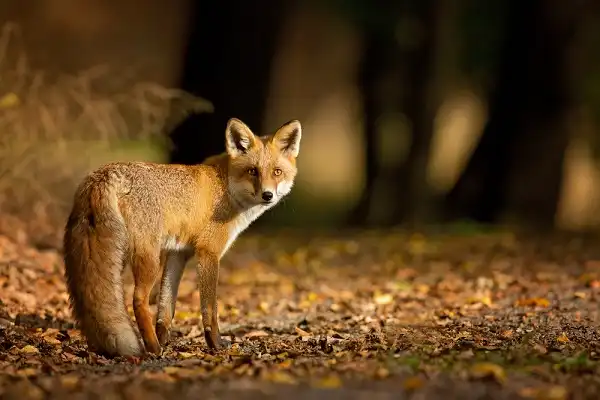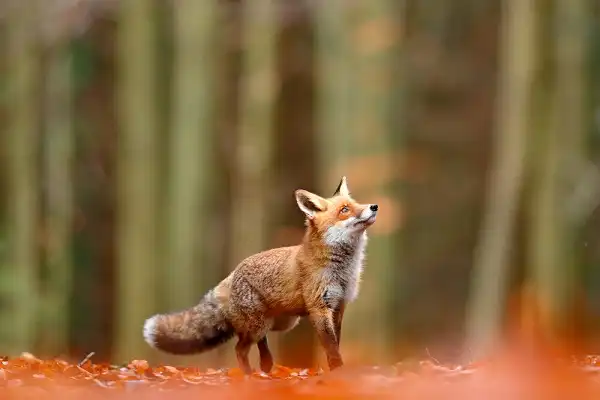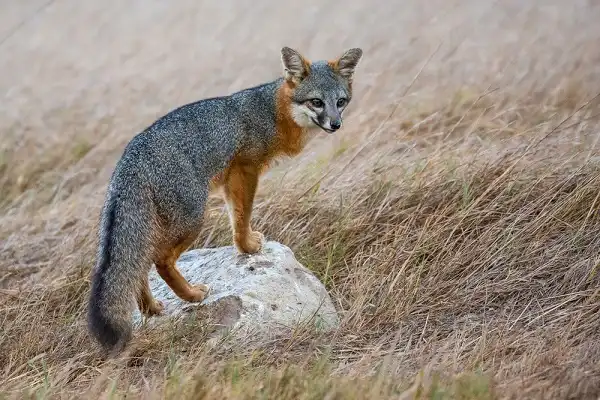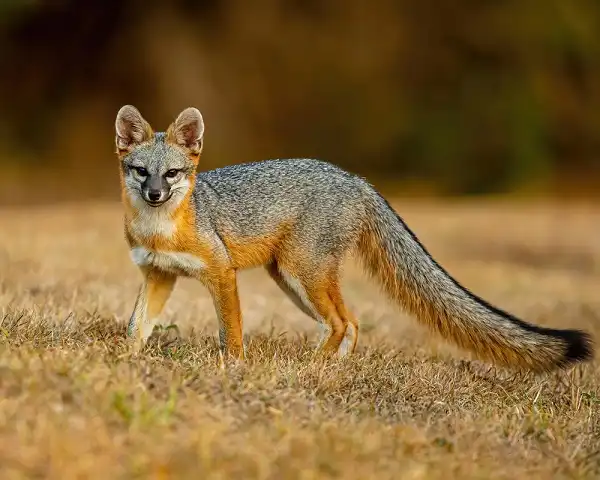Foxes are one of the most popular animals in North America and for good reason. These fascinating creatures are known for their cunning intelligence and playful personalities. Although they are often considered pests, foxes play an important role in the ecosystem by preying on small mammals and invertebrates. Read on to learn more about these fascinating creatures!

Fox Description
Foxes are members of the dog family, Canidae, and have a range of sizes and colors. Their fur color is typically shades of red or gray, with some species having white or black fur. They usually have big ears that help them detect predators and prey from long distances. Foxes also have sharp faces, bushy tails, and large eyes. For many centuries foxes have been depicted in folklore tales around the world as cunning tricksters who take advantage of those around them through deception or misdirection tactics. Today foxes play an important role in ecosystems by keeping rodent populations under control as well as providing food sources for larger predators like coyotes or eagles which helps maintain population balance across different species within an ecosystem.
Fox Habitat
Foxes are highly adaptable creatures and can live in a variety of habitats. They prefer areas with plenty of vegetation, such as forests, grasslands, and mountain regions. They also inhabit deserts and arid regions where food is scarce, but they generally avoid areas with high human populations. Foxes also thrive in urban environments, where they can find plenty of food and shelter among abandoned buildings or parklands. In nature, foxes establish dens or burrows that they use as homes and shelters. These dens are often found on the side of hills or beneath large rocks. Foxes may also take up residence in abandoned badger holes or other animals’ dens if available. Inside their den, foxes will create nesting chambers with leaves and other materials to make a comfortable home for themselves and their young. Foxes have adapted well over time to survive in urban settings by taking advantage of human garbage dumps providing access to easy meals and even utilizing lawns as hunting grounds filled with small rodents like mice and voles that make tasty snacks for these predators!
Fox Diet
Foxes have a very diverse diet that consists of small mammals such as mice, voles, and rabbits, as well as birds, insects, and even fruits and vegetables. They will take advantage of whatever food sources they can find in their environment. Foxes also scavenge on carrion that they happen to stumble upon while out hunting. In urban environments foxes often rely on human garbage or discarded pet food for sustenance. They are opportunistic feeders and will eat just about anything that is available to them. Foxes have been known to consume some pretty unusual items such as frogs, fish, salamanders, snakes, lizards, and even large insects like grasshoppers or crickets! As omnivores foxes are able to supplement their diet with plant matter such as berries, fruit, nuts, and roots that provide important vitamins and minerals necessary for maintaining health when animal protein may not be readily accessible. Overall fox diets vary depending on the time of year and what type of habitat the fox is living in but one thing is for certain – these cunning creatures have developed an impressive array of survival strategies over time allowing them access to a wide variety of different food sources even in the toughest of environments!

Fox Size
Foxes are medium-sized mammals, ranging in size from 1.2 to 3.3 feet in length and weighing between 5 and 15 pounds. The smaller species of fox such as the Red Fox (Vulpes vulpes) and the Fennec Fox (Vulpes zerda) can weigh as little as 2 or 3 pounds while the larger species such as the Gray Fox (Urocyon cinereoargenteus) can reach up to 20 pounds! Although foxes tend to be slender and small animals, they have thick fur coats that provide them with warmth and extra protection during colder climates. The size of a fox is largely determined by its species and habitat, for example, Arctic Foxes (Vulpes lagopus) are well adapted to survive in extreme cold weather environments and therefore tend to be larger than other species due to their thick white fur which helps them stay warm. On the other hand, desert-dwelling foxes such as the Fennec Fox are much smaller than their Arctic counterparts since their smaller bodies require less energy to keep cool under hot temperatures.
Fox Lifespan
Foxes are relatively long-lived animals, with some species having lifespans of up to 14 years in the wild and up to 20 years in captivity. Arctic foxes tend to live longer than their desert-dwelling counterparts and can reach an age of 10 years or more. The lifespan of a fox is largely determined by its species, habitat, and lifestyle; Arctic foxes living in colder climates tend to live longer due to the availability of food sources and protective winter dens which help them survive harsh conditions for extended periods. On the other hand, smaller species like Fennec foxes living in deserts may have shorter lifespans due to heat stress and limited access to food sources during dry seasons. Foxes also experience accelerated aging caused by exposure to environmental toxins such as pesticides or heavy metals which can reduce their lifespan significantly. Additionally, injuries resulting from territorial disputes or predation by larger predators can significantly shorten a fox’s life expectancy. Despite these setbacks, some fox populations are able to thrive with healthy populations living up to 8-14 years in the wild if disease, predation, and human interference remain low. Female foxes often outlive males due to their innate ability for better resource management which gives them an overall advantage when it comes to survival instincts.
Fox Behavior
Fox behavior is an incredibly fascinating subject that has gained much attention from scientists in recent years. Foxes are known for their adaptive and clever behaviors which allow them to thrive in a variety of habitats. They can be found living on all continents except for Antarctica and exhibit a wide range of behavioral adaptations depending on the environment they inhabit. In general, foxes are solitary animals that prefer to live alone or in pairs with their mate during mating season. However, some species may form small family groups which consist of a breeding pair and their offspring who stay together until they reach adulthood.
In addition to having strong family ties, foxes also demonstrate complex social structures and communication abilities – they have been known to use over 20 different vocalizations including barks, growls, whines, and screams! Foxes are also very resourceful animals with an innate ability to find food sources despite challenging environmental conditions. For example, Arctic foxes have been observed digging through snowbanks to search for prey while desert-dwelling foxes have developed strategies such as stealing eggs from birds’ nests or raiding communal caches set up by other animals like prairie dogs. To conserve energy when searching for food, some foxes even engage in “sit and wait” hunting tactics where they patiently wait for a meal to come into view before pouncing on it!

Fox Speed
Foxes are known for their incredible speed and agility which allows them to outrun many predators. Depending on the species, foxes can reach top speeds of up to 40 mph when running short distances at full tilt. They achieve these impressive speeds by relying on a combination of powerful leg muscles and an incredibly flexible spine that allows them to twist and turn rapidly while sprinting. On average, foxes have an impressive acceleration rate – they can reach peak velocity in just six strides! This is due to their strong hind legs which provide explosive bursts of power needed to reach maximum speed quickly. Additionally, foxes possess an exceptional degree of coordination – they can change direction with lightning-fast reflexes and make sharp turns without losing momentum. In terms of endurance, foxes are also very capable – studies have shown that some species can jog for up to ten miles without tiring! This is partly because they possess a unique “double bounce” running style which enables them to cover greater distances without expending too much energy. Furthermore, their large hearts and lungs enable them to take in more oxygen which helps their bodies sustain high levels of activity for longer periods of time.
Fox Hunting
Fox hunting is an activity that has been practiced for centuries, and foxes have long been considered a popular game animal. Foxes are cunning and adaptable, making them a challenging quarry for hunters. They rely on their keen senses of smell, hearing, and vision to evade predators and outsmart pursuers. When hunting foxes, it is important to remember that they generally travel alone or in small packs of two or three. It is also important to note that foxes have an incredible ability to camouflage themselves in foliage and blend into their environment, so they can be difficult to spot even with binoculars. Many experienced hunters use hounds such as foxhounds or beagles as well as terriers when hunting these wily animals. The hounds are trained to follow the scent of the fox, allowing the hunter to locate the prey more easily. Fox hunting may involve chasing down a single fox with a gun and dogs – a practice called ‘drag hunting’ – or stalking multiple foxes within an area with scent hounds over larger distances which is known as ‘trailing’. Depending on the method used, different strategies must be employed by the hunter in order to successfully catch the elusive quarry. For instance, when drag hunting it is important for the hunter to move quickly but quietly so as not to alert the fox before he gets close enough for a shot – the speed here can be just as important as stealth!

Conclusion
Foxes are incredibly fast and agile animals, giving them a significant advantage over many other species when it comes to survival in the wild. Their extraordinary speed and agility also make them sought-after game animals for hunters who practice fox hunting as a form of sport and nature conservation. With their impressive physical capabilities, foxes have managed to thrive in even the harshest of climates – a testament to their incredible adaptability! With all this in mind, it is clear that foxes are amazing creatures that have earned a place among some of nature’s most remarkable survivors. Through their unique abilities and strength of spirit, these beautiful animals continue to thrive even in the face of daunting odds – a true testament to their sheer determination!
Frequently Asked Question


